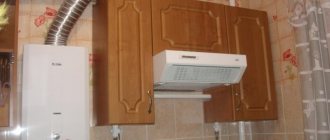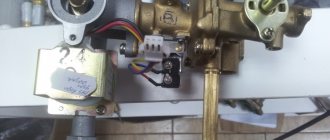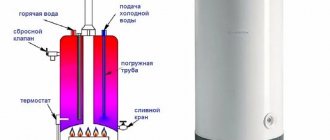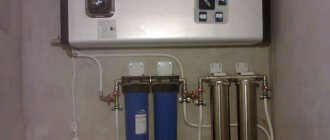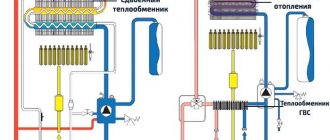A gas water heater is a household appliance with an average service life of up to 15 years or more. But in practice, this period may be shorter, which entails the need to purchase new equipment. This is due not only to the physical wear and tear of the components, but also to the obsolescence of the device.
For you, like most owners, replacing a gas water heater in an apartment raises many questions and doubts about the correctness of the actions, doesn’t it? What standards and requirements must be observed so as not to break the law and not put your life and property in danger?
In this article, we will give tips and recommendations on replacing a gas water heater, preparing the necessary documents, and will help you avoid mistakes and miscalculations when installing the device. We will provide our material with diagrams, examples of documents and visual photos, as well as videos.
Steps to take when replacing a gas water heater
If gas water heating equipment fails or it is decided to replace it with a more modern model, then the following nuances should be taken into account:
- It is forbidden to connect the gas water heater to the gas supply system independently;
- the basic requirements for the placement of the device are described in building codes and installation rules 42-01-2002 and SP 42-101-203;
- To replace or install, you will need to collect the necessary documentation.
It is worth considering that to replace a flow-through heater you will need one set of documents, and to transfer or initially install another. The area of the room where it will be mounted must be at least 8 m². Gas water heaters are not installed above the 11th floor.
First you need to select a model, then collect a package of documents. After collecting all signatures and agreeing with specialists, the old installation is removed, then a new column is installed.
Basic standards and requirements
Since the device uses highly hazardous fuel, its installation and operation are subject to strict rules and regulations. According to the law, all work, from making changes to the project to connecting the column, must be performed by organizations or specialists licensed for this type of activity.
If the technical documentation is correctly completed and all requirements and conditions are met, dismantling the old and installing a new column is not very difficult.
Owners need to know the basic requirements, who should change their household gas water heater and how, especially owners who are accustomed to organizing their lives independently
The technical conditions for installing a water heater are dictated, first of all, by the safety of using gas equipment. The standards and requirements for replacing an old gas water heater with a new one are stipulated by the manufacturer’s instructions, building codes and gas supply rules SNiP 2.04.08-87*.
Premises requirements
A flow-through gas heater is installed in the kitchen or other non-residential premises with a volume of at least 7.5 m³, if there is an air flow through a ventilation grille with an area of 0.03 m² or more.
The ease of removability of the structure also depends on the size of the windows. This means that in the event of an emergency explosion of a gas mixture with air, the excess pressure is neutralized through windows, doors or other provided elements without destroying the building.
The volume of the room, the dimensions of window and ventilation openings must meet the requirements to ensure sufficient air circulation through the water heater
The required window area depends on the thickness of the glass and is determined as follows:
- with a thickness of 3 mm, the area should be at least 0.8 m²;
- for 4 mm - at least 1 m²;
- at 5 mm - from 1.5 m².
Only the area of the glazing itself should be taken into account without taking into account the frames. The ceiling height must be at least 2 m (with a sloping ceiling of 2.2 m) for devices up to 60 kW, and from 2.5 m for equipment with higher power.
When replacing an old speaker in a bathroom, it is permissible to install it in its original place, although in cases of initial design, according to modern standards, this is prohibited.
It is also necessary to take into account that high humidity leads to corrosion of components and shortens the service life of the device. In this case, it is better to replace the water heater by moving it to a new, more suitable location.
Standards for column location
In the passport for the gas water heater or installation instructions, as a rule, the manufacturer indicates the required distances from the device to the building structures of the room. If there are no such instructions, the gas heater is installed based on ease of use, installation, maintenance and repair.
When installing the speaker, you must adhere to the recommended distances from the device body to walls and nearby objects. This will provide the necessary ventilation and eliminate the risk of overheating and fire.
Installation must be carried out in compliance with the distance from the mounting wall, depending on its fire-fighting properties:
- from fireproof materials - not less than 2 cm;
- from fire-resistant, combustible, protected by sheet steel, asbestos from 3 mm, plaster, etc. - at least 3 cm.
The dimensions of the thermal insulation must exceed the dimensions of the column by at least 10 cm around the perimeter and 70 cm on top. The distance to the nearest structures, walls, objects should not be less than 15 cm on both sides of the device. If the device data sheet allows installation with a reduced gap, then it is necessary to provide protection for adjacent surfaces with non-combustible materials. But in any case, the gap should not be less than 3 cm.
The burner window should be located approximately at eye level. If the gas heater is installed in a passageway, then a free space of at least 1 m should be provided around it.
Requirements for ventilation and chimney
The chimney must ensure complete removal of combustion products naturally with the following volume distribution:
- hoods - at the level of 3 times air exchange in one hour;
- air flow from the room - not less than the total volume of exhaust air and air spent on gas combustion.
For equipment over 60 kW, an additional calculation of the size of ventilation devices is performed.
Also, do not forget about the ventilation of the device itself. Failure to maintain the recommended distance of 15 cm from the side wall will result in insufficient ventilation on the left side of the speaker and local overheating.
Galvanized or stainless steel is recommended as a chimney material. According to the type of design, it can be a sandwich pipe, corrugated pipe or a coaxial chimney in the case of a turbocharged water heater. Aluminum corrugation should not be used due to its susceptibility to rapid burning.
The total length of the pipe, from the top of the column to the opening of the chimney duct in the wall, should not exceed 3 m. In this case, it is necessary to observe the maximum number of turns at right angles - no more than two. If there are more of them, then you should subtract 1 m from the total length for each 90-degree turn and 0.5 m for each 45-degree angle.
The length of the vertical acceleration section of the chimney at the outlet of the column must be at least 25 - 30 cm with a ceiling height of up to 2.7 m. In rooms with a higher ceiling, it is recommended to increase it to 50 cm. The horizontal part is mounted with a minimum upward slope of 2 degrees.
Requirements for gas supply hoses
When replacing supply pipes and gas water heater hoses, it is necessary to take into account the gas inspection requirements for their type and material of manufacture.
Flexible hoses for gas are rubber, metal braided, bellows made of stainless steel and polymers, PVC. The main criterion for the right choice is the presence of a yellow sticker or coloring and a certificate. To avoid fakes, it is recommended to buy them in specialized stores. The most preferable option is a bellows hose or PVC hose.
The dielectric insert significantly increases the safety of using the geyser
The length of the gas supply hose should not exceed 1.5 - 2 m with an internal diameter of 15 mm. It cannot be bent or pulled sharply. At the point where the bellows hose is connected to the gas pipe, it is necessary to install insulating adapters to protect both the device itself and the gas pipeline from stray currents and discharges.
Who has the right to change a column
All preparatory work for dismantling and installing the water heater can be done independently. Disconnection from the system and a test run is performed only by a gas service specialist. This is stated in the rules.
Replacing a heater is not a difficult task, but for unauthorized installation there is a fine of 10-15 thousand rubles. If, after self-connection, an accident occurred that resulted in damage to property or the death of a person, then the punishment will be more severe.
The installations are carried out by service centers, and they also issue a commissioning certificate. Without this document, the geyser will not be supplied for warranty service. You can find such a company on the Internet. On the service center’s website you will be able to find out not only what kind of work the company performs, but also how much it costs to replace a gas water heater.
On average, installation will cost 3-5 thousand rubles. The cost of work depends on the brand of the device and the complexity of the connection. Additionally, the master can charge money for dismantling old equipment. When choosing a company to install a speaker, you need to check whether it has the appropriate license.
In addition to service centers, city gas specialists are responsible for replacing water heating equipment. They can also service the dispenser in the future and promptly warn about the need for repairs.
Consequences for the violator
Penalties for unauthorized use of fuel and installation of equipment include:
- Sanctions from the fuel supplier in accordance with the Decree of the Russian Federation dated July 21, 2008 No. 549.
- Fines under Article 7.19 of the Code of Administrative Offenses of the Russian Federation.
- Criminal liability under articles 158 and 109 of the Criminal Code of the Russian Federation.
What sanctions are provided for by the legislation of the Russian Federation:
- The supplier may cut off the intruder from the line. For unauthorized installation of equipment, the fine will be 45,000 rubles.
- Administrative liability: for citizens - 2,000, for officials - 4,000 and for organizations - 40,000 rubles.
- Imprisonment for up to 2 years.
- If there was an accident and people died, then up to 5 years in prison.
It remains to figure out how to do the right thing and what standards to follow.
How often should the column be changed?
Water heating geysers are durable devices. The service life of a new unit is on average 10-15 years. It is influenced by the following factors:
- quality of heated water;
- presence of a filtration system;
- manufacturer's reliability.
All heating equipment is subject to annual scheduled inspection. This is done by service center specialists or local gas workers. With high-quality maintenance and timely replacement of consumables, the device will last a long time.
Standards for placing a gas water heater in an apartment
It is important to adhere to the rules for installing a geyser for fire safety purposes:
- room standards: the kitchen area must be at least 7.5 square meters. m.; the minimum ceiling height in the apartment is 2 m;
- chimney opening diameter – not less than 120 mm;
- the column must be mounted on a brick or concrete wall, and for better protection (to avoid fire), it is important to install galvanized sheets during installation;
- natural ventilation is a prerequisite for installing a column;
- It is prohibited to install the device directly above a gas stove;
- the column must be placed at a distance of at least 1.5 m from electrical appliances;
- An extractor hood for a geyser in an apartment must be installed in the kitchen, since combustion products must be vented outside. In the apartment, these products are removed through the ventilation duct. According to the standards, no more than 2 units can be connected to one hood. And you can install the hood only near a wall made of non-combustible materials;
- Special sensors must be present so that they can be used to monitor the presence of combustion products in the air. This is necessary so that when the level of combustion products in the air exceeds the level, the sensors can turn off the gas supply or notify residents of the problem;
- in the kitchen where the gas water heater is located, there must be a door;
- It is prohibited to mask gas pipes and the column itself. Gas technicians should always have easy access to equipment and pipes.
What documents are needed when replacing a column?
To replace a flow-through heater with one identical in size and power, you need:
- Gas and water supply diagrams. Issued by the housing office or management company.
- Chimney duct diagram. Also issued by a housing company.
- Inspection report for chimney and ventilation shafts. Issued by the fire department.
- Application to replace the dispenser without changing the location and power of the unit.
- Technical data sheet and safety certificate for the new dispenser.
When changing the location or power of the heating device, it is necessary to order new technical documentation and a project for installing the unit.
To do this you will have to contact a specialized company. After developing the plan, it must be approved by the fire service, gas utilities, water utilities, and city authorities. Only then do they begin to replace the equipment.
To avoid having to do this yourself, you can hire people who will collect a package of documents and then install the water heater.
Legal basis for installing gas equipment
Considering the special importance of gas supply for the population as an energy source, Federal Law No. 69-FZ was adopted in 1999, which is called: “On gas supply in the Russian Federation.”
The law regulates the entire complex of relationships that arise between the gas production industry, the gas transportation system and gas consumers. However, there is no direct answer to the question of how the owner of the premises should act and what documents will need to be submitted in order to obtain permission to install gas equipment.
Is it possible to replace the water heater with a water heater?
You can replace a gas water heater not only with a newer model, but also with an electric water heater. The law does not prohibit apartment owners from abandoning gas-fired water heaters.
To do this, you need to contact your local gas service. An application for refusal of a gas water heater is written by the owner of the apartment. In addition, it will be necessary to provide documents confirming the ownership of this housing, as well as a valid gas supply agreement.
Gorgaz employees come, turn off the pump, put a plug on the pipe, and seal this gas supply point. If in the future it is necessary to remove the inlet, then it will be necessary to make changes to the design documentation. The service for disconnecting and connecting gas is paid.
After this, you can begin installing the electric water heater. No permits are required for its installation.
Compliance with technical conditions for installing gas equipment
In addition to following the procedure for agreeing and preparing technical documentation, it is required to comply with the technical conditions for installing gas equipment. They are carried out in accordance with:
- SNiP 2.04.08-87 “Gas supply”;
- DBN V.2.5-20-2001. (Appendix G) – when installing chimneys;
- SP 41-108-2004 - concerns fire safety rules for materials enclosing a gas water heater.
Responsibilities for compliance with the requirements set out in SNiP and TU rest with the gas service workers who install the equipment, but the owner of the residential premises must also monitor the progress of the work. Therefore, before starting work, it is useful for him to familiarize himself with the contents of these documents.
If deviations from the rules are made during the execution of work, this must be indicated in the work completion report and the head of the gas service must be notified so that the admissibility of deviation from the specified standards or non-compliance with the technology (sequence) of work execution can be assessed.
Particular attention should be paid to this due to the high danger of operating gas equipment, which can cause material damage or pose a threat to the life and health of the consumer.
Pros and cons of a gas water heater in an apartment
When deciding whether to install a gas water heater in an apartment or prefer a boiler, it is important to note all the advantages and disadvantages of this method of heating water.
Pros:
- there is always hot water;
- you can quickly heat a large amount of water;
- no need to pay for hot water;
- You can connect home heating to the column (if the column is double-circuit).
Minuses:
- explosion and fire hazard;
- the presence of a gas water heater requires good draft (if there is no draft, there is a risk of carbon monoxide poisoning);
- a chimney and good ventilation are necessary - this point must be taken into account when designing a kitchen.
Installing a gas water heater in an apartment is a serious undertaking that requires obtaining the necessary permits and knowledge of which water heater to buy, whether the device can be installed in an apartment building, where to go, how to install it correctly, etc.
The installation of a gas water heater should be trusted only to specialists - only they know exactly how to install the equipment correctly in accordance with the rules and regulations.
It is prohibited to install the water heater yourself, otherwise the apartment owner will face administrative and/or criminal liability.
Features of self-installation
In the case of a simple replacement of the unit, its installation can be carried out without the involvement of specialists, since the communication connections are already available and all that remains is to change the equipment.
When carrying out installation operations, the following points must be taken into account:
- First, you should mark the mounting points for the speaker on the wall, for which you first need to remove its mounting dimensions;
- the hanging location should be chosen in such a way that the distance to the nearest outlet is at least 0.5 meters (with a room height of up to 2.75 meters);
- with a higher room height, this distance may be slightly less (up to 0.25 meters).
For safety reasons, the height of the gas water heater on the wall should not allow small children to reach the control panel. It is very important to accurately measure the distance between the mounting holes, which allows you to hang the speaker on hooks or special brackets without any difficulty. Taking into account all the factors listed above, installing a speaker comes down to simply hanging it at the desired height.
Preparation
Before replacing or installing a new geyser, the site is prepared.
If replacement is intended, the old column is dismantled. Be sure to check the quality of closing the valve on the gas pipe to avoid gas leakage. All valves on the water pipes are closed.
The pipes from the column and the flexible gas hose are disconnected, and the chimney is dismantled. The column is carefully removed. Often, this requires removing the front panel and then unscrewing the fasteners.
The wall under the column most likely requires cosmetic repairs. Old fasteners are removed, and the holes left behind are sealed with mortar.
For final installation, the wall is leveled. A special adapter is attached to the chimney opening for connecting a flexible corrugated pipe 110-120 mm.
- Impact drill or hammer drill and a set of 8-10 mm drills;
- A set of fastenings (self-tapping screws with a hook, anchors). The size and type of fastenings are determined in accordance with the requirements of the speaker manufacturer;
- Bubble or laser level.
To access the speaker mounts, remove the front panel. According to the markings of the geyser fastenings, mark on the wall places for installing hooks or anchors. Be sure to check the position of the marks according to the level. Using a drill or hammer drill, two (four) holes are drilled into which dowels or anchors are inserted.
Most modern gas instantaneous water heaters have a mounting plate. It is this that is attached to the wall, and then the column is attached to it using latches. The task in this case is simplified; it is enough to attach the plate to the wall, level it and mark the places of fastenings along it.
Drill one hole at the required height and secure the plate, then, aligning it level, drill the remaining holes directly through the holes for the remaining fasteners and complete the installation.
All that remains is to fix the column in its place. It is too early to reattach the front panel, so carefully set it aside so as not to scratch or damage it.
The chimney for a column with an atmospheric burner can be a corrugated steel pipe of 110-120 mm, laid from the outlet of the column to the entrance of the common chimney. The pipe should fit tightly to the sockets; if this is not the case, then additionally crimp it with a metal clamp.
For columns with a closed combustion chamber, orient the outlet inside the column in the desired direction and lay a coaxial chimney to the nearest wall in contact with the street. The maximum permissible length is indicated in the instructions.
The wall is passed through with a hammer drill, after which the chimney is inserted. The gap between the pipe and the wall is foamed or filled with non-flammable insulation, such as basalt wool.
Connection to the gas pipeline.
When laying pipes indoors to the gas pipeline, the requirements of SNiP 62. 13330. 2011 are observed.
1. They cut into the highway after the section with the meter.
2. They use pipes made of steel or polymer material created for LPG or gas.
3.The gas pipe is equipped with a valve to adjust the operation.
4. The connections are made permanent, pipe laying method: open, can be in a groove.
5. The passage of the pipe through the partitions in the wall is carried out using a steel or plastic case.
Premises requirements.
According to SNiP, it is prohibited to install water heating columns in rooms that are not suitable for this: in the bedroom, in the nursery, in the living room.
Rooms where speakers can be installed:
1.in the kitchen.
2. in a combustion room located inside a building or in an extension.
3. in another room for technical needs, for example, in the basement, on the ground floor, if they have an outer wall with a window.
4. corridor, provided that other solutions are impossible.
An important condition for permitting installation is: in the room for the speaker there must be an external wall of the house with a light opening with the necessary parameters. In emergency situations, this guarantees that the blast wave will be directed onto the street through the window, the glass will be broken, and the partitions will not be damaged.
How to calculate the window size: per cubic meter of room there should be 0.03 square meters of glass.
According to SNiP 62.13330.2011 in paragraph 7.6 it is not allowed to install speakers with a bathtub or in a bathroom. There are no windows in the room, poor ventilation due to the small dimensions of the ventilation shaft.
The toilet and bathroom are always humid, air with water droplets will enter the burner, forming condensation, and a lot of gas will be required to dry the droplets.
The room parameters for the speaker must meet the following requirements:
1. The minimum volume that is acceptable is 7.5 cubic meters.
2. The distance to the ceiling is two meters.
3.window area is 0.03 square meters per cubic meter of room.
Attention! If there is a boiler and a water heater in the house, the distance to the ceiling increases by half a meter.
Removing the old column
When replacing equipment, first dismantle the old one, following the instructions below.
Sequencing
- Close the valve on the gas pipe, eliminating the flow.
- Unscrew the nut securing the hose using a suitable wrench.
Important! To prevent damage to the gas pipe, hold it with a second wrench.
- Remove the hose from the entry point.
- Check the condition of the hose - if it is satisfactory, use it for further operation of the new column.
- Turn off the water taps at the entrance to the pump.
Important! If these have not been installed before or you are installing new equipment, buy taps in advance and install them at the inlet and outlet of the pipeline to the device.
- Remove the pipe connecting to the chimney.
- Remove it from the chimney.
The last steps apply only to the type of column in which combustion products are removed through a chimney.
Common Mistakes
Our people are not afraid of fines for unauthorized installation of water heaters, so water heating equipment is often placed incorrectly in apartments.
However, experts strongly do not recommend making such mistakes when installing a geyser:
- The speaker cannot be placed in the bathroom, since there is no natural ventilation in this room (no windows).
- There is no need to hide the unit in a closet - this leads to disruption of the functioning of the device.
- You cannot connect the gas yourself. Some people confuse a water pipe with a gas pipe. If water gets into the main line, this can lead to equipment failure, stopping the gas supply not only to the person who made the incorrect connection, but also to all neighbors of the house.
Preparatory operations
If you have permission to connect the device yourself, the installation procedure looks like this.
You should start by closing the channel of energy supply into the gas water heater using the appropriate valve. After this, it will be possible to disconnect the supply hose (pipe) from the fitting at the inlet to the unit.
Important!
If there is the slightest doubt about the reliability of a used hose, it is necessary to replace it with a new one.
At the next stage, it will be possible to proceed to disconnecting the water supply channel from the unit (if there is a shut-off valve at the inlet pipe). If it is absent, you should shut off the channel entering the apartment, having first prepared two spare valves (for the input and output of the distribution circuit).
After this, it is necessary to dismantle the connecting pipe located at the outlet of the column, and then carefully separate it from the attachment to the chimney opening.
A completely disconnected speaker remains to be removed from the brackets that secure the product to the wall. After this, you can proceed to the installation of a new unit, hung in the old place in accordance with the rules for installing geysers.


